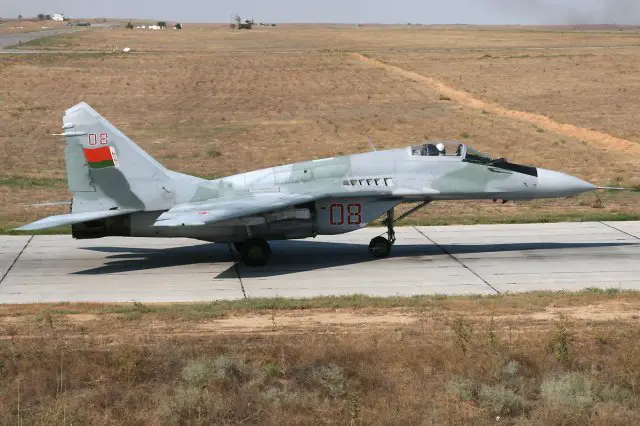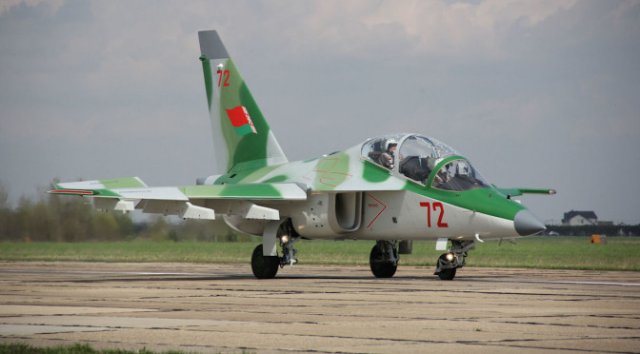Belarusian Air Force facing hard times
| a | |||
|
|
|||
|
Air Force in the world - Belarus
|
|||
|
|
|||
|
Belarusian Air Force facing hard times
|
|||
|
The Republic of Belarus is lucky in the sphere of military build. It inherited from the Soviet Union one of the best military districts located on the main Western strategic direction. It was a second-tier echelon of the forces deployed in Warsaw Pact countries (East Germany and Poland). Belarus also got a number of military-defense enterprises that produced complex electronic systems, in particular.
|
|||
|
|
|||
 A BAF MiG-29 fighter aircraft A BAF MiG-29 fighter aircraft |
|||
|
|
|||
|
Belarus does not have such costly and complex arms of the armed forces as Strategic missile forces (it handed over 81 Topol intercontinental ballistic missiles to Russia yet in the 1980s) and the Navy. The republic has a small territory without extreme climatic conditions. No mountains, deserts or tundra. All this simplified and made the military build less expensive.
Deputy Director of the Institute of Political and Military Analysis Alexander Khramchikhin believes Belarus created an armed force which was the best in the CIS in many parameters for a long time. Despite limited financial possibilities its army had a high combat capability and morale of the servicemen who enjoyed major social benefits. The armed forces underwent structural reforms and received two strategic commands (Western and Northwestern), as well as territorial troops which protect and defend important objects from airborne assault of the adversary, subversions and terrorist attacks. Ground forces switched to brigade structure which better fits a small country and the corps were abandoned after the commands were set up. However with such a territory and common directions of potential threats the creation of two strategic commands looks excessive. No wonder they have already been abolished in the Air Force. The Belarusian Air Force has four bases: 61st fighters in Baranovichi, 116th attack in Lida, 50th combined in Machulishchi, 181st helicopter in Pruzhany. The fleet comprises 27 Su-25 fighters (including 9 Su-25UB) and six MiG-29 (12 BM and 8 UB). There is also a stock of close to 40 attack jets Su-25 (which are likely to be decommissioned completely) up to 26 tactical bombers Su-24 (for sale abroad), and up to 23 fighters Su-27 (including 4 Su-27UBM1) the fate of which is unclear. Heavy lift is purely symbolic and has only two Il-76 and three An-26. Another five An-26 and one An-24B are stored in hangars. |
|||
|
|
|||
 A BAF Yak-130 light attack and training aircraft A BAF Yak-130 light attack and training aircraft(Credit: Irkutsk) |
|||
|
|
|||
|
Belarus inherited from the Soviet Union close to 120 military-defense enterprises but no end-product facilities. No armaments were produced in the country, but only road vehicles, as well as various equipment. However Belarus has a series of maintenance enterprises.
Khramchikhin believes in contrast to Ukraine the Belarussian leadership rationally used the Soviet heritage, preserved integration relations with Russia which is the main consumer of its military products. Most of supplies still comprise piloting systems, navigational devices, satellite and space communications, radio stations and antennas, stationary and onboard computer complexes, optical-mechanical, assembly and control equipment for the production of super big integrated circuits, tools for precision optics, chemical products, electronics, heavy wheel chassis, trailers and semi-trailers. Topol and Topol-M intercontinental ballistic missiles are mounted on the chassis of Belarussian-made MAZ-7310 and MAZ-7917 heavy trucks. Elements of S-300P (radar, controls launcher) are mounted on MAZ-543 chassis. On the other hand, all hardware of the Belarussian armed forces is Russian-made. However there are modifications of Russian armaments, for example, salvo fire system BM-21 Grad (renamed into Belgrade), Shilka anti-aircraft (ZSU-23-4M5), and Su-27 and MiG-29 fighters (Su-27BM and MiG-29BM). The 140th maintenance enterprise designed a new reconnaissance and subversion vehicle 2T. Belarus produces automatic control systems of various levels, electronic and optical systems. The 558th aircraft maintenance enterprise successfully mastered the production of drones. Belarus actually leads in drone production on post-Soviet space. Moscow and Minsk jointly work for arms exports both to the countries of the Collective Security Treaty Organization and outside the former Soviet Union. Thus, enterprises of both countries cooperate to modernize light PT-76 tank, BTR-50P armored personnel carriers and S-125 anti-aircraft missiles. The hardware is no longer used in our countries but abounds in other states that acquired armaments from the Soviet Union. |
|||
|
|
|||
 Two BAF Mi-24 attack helicopters Two BAF Mi-24 attack helicopters |
|||
|
|
|||
|
Belarus does not attempt to produce everything itself. On the contrary, it deepens specialization and puts out equipment which is extremely important in modern warfare as it is impossible to network the armed forces without means of communication, navigation, reconnaissance, monitoring and control. The Belarussians succeeded to create unique means of radio-electronic warfare.
Khramchikhin believes the current situation in Belarus and its armed forces is far from cloudy. Its "economic miracle" which surprised many in Russia was based on refining cheap Russian oil (Belarussian refineries were the best in the USSR) and selling fuel to Europe at world prices. The miracle ended after Moscow stopped "feeding" Minsk. No trace of the miracle remains at present. Khramchikhin estimates the social and economic situation in Belarus as catastrophic. It also affects the armed forces. The level of combat training began to decrease and monetary allowances and social benefits of the military are declining. Besides, combat hardware is exhausting its resource, specifically in the Air Force. Belarussian armed forces (like Ukrainian and Russian) need a total rearmament. But there is no money for that and will hardly be in the future. Belarussian President Alexander Lukashenko is convinced that Russia has to rearm his army at its own expense (at least at domestic prices). However Moscow is not ready for that as it faces its own economic problems. |
|||
|
|
|||
|
© Copyright 2015 TASS. All rights reserved. This material may not be published, broadcast, rewritten or redistributed.
|
|||


























